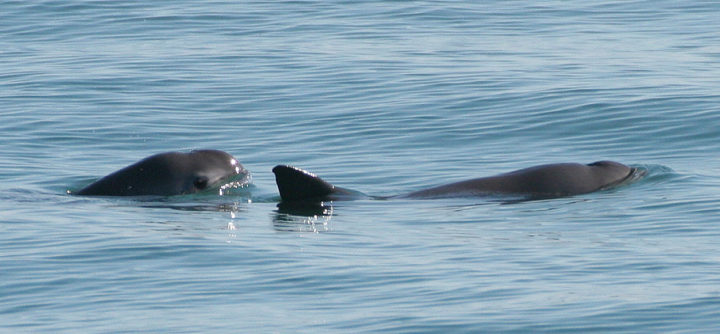Image Source: Wikimedia Commons
It is the year 2021, and there are only ten or fewer vaquitas left in the world today. Environmentalist groups such as WWF, Sea Shepherd Conservation Organization, and the International Union for Conservation of Nature’s (IUCN) efforts to preserve them could not compete with violent cartels that invade the vaquita’s tiny bit of the sea.
The vaquitas live on a sea that flows between Baja California and Mexico. In size, it occupies 1,519 square miles, an area that is ¼ the size of Los Angeles. A government agency in Mexico is on the verge of giving up, because it believes that with so few vaquitas left, it will be impossible to save, much less replenish them.
However, environmental groups are appealing to the US government and international organizations to sanction Mexico by banning Mexican exports, in this way exerting pressure on the Mexican government to protect the last remaining vaquitas by putting a complete end to the use of gillnets, which are the major cause of the death and near extinction of this tiny porpoise.
Caught in the crossfire
The vaquitas have mostly died because they were caught in the crossfire of legal fishermen and cartels. The fishermen used gillnets to catch shrimp and finfish. But in making their living, vaquitas were trapped at the bottom of the sea, their heads stuck in the gillnets. Vaquitas need to go up above sea to get oxygen in order to live. Due to the gillnets, many vaquitas died of suffocation.
Sea environmentalists provided an alternative net for the fishermen which didn’t reach to the bottom of the sea. The nets enabled the fishermen to continue with their livelihood, and in April 2015, Mexico’s then-President Pena Nieto announced a two-year emergency ban on gillnets. Furthermore, the government provided fishermen a monthly fee to compensate for their loss of income.
Cartels for the totoaba
This however didn’t stop poachers from continuing to use gillnets. Not because of the vaquitas, but because of the totoaba, a marine species fish with swim bladders that sell for up to US$ 20,500.00 in illegal trade. These bladders command a high price because they are used in traditional Chinese medicine to cure a number of ailments such as arthritis.
And so, despite Mexico’s government ships patrolling the waters occupied by the vaquita, and despite efforts by the environmentalist Sea Shepherd to pull out illegal gillnets in the prohibited area that is home to the vaquita, the poachers continued to thrive. That’s why now there are less than 10 vaquitas alive today.
Other reasons
The latest decision by this Mexican agency may also be influenced by the death of a fisherman last January 2021. It happened when the Sea Shepherd’s boats were guarding a portion of water where most vaquitas stayed. They had just pulled out one of the illegal gillnets used by poachers.
For some time now, there had been long-ranging discord between the Sea Shepherd and poachers. On this particular night, as they were pulling the gillnets out of the waters, a group of boats approached them and aggressively threw Molotov cocktails at the Sea Shepherd.
Following protocol, the Sea Shepherd tried to escape rather than confront the poachers. But in doing so one boat quickly rammed the Sea Shepherd vessel, causing the two fishermen to fall out of their boat, which was rammed in half. One fisherman who was pulled out of the boat was dead, and the other was injured. The Sea Shepherd administered first aid to the man.
The incident caused a public uproar. Citizens blamed the Mexican government for placing greater value on the vaquita and international conservationists than on their own people.
Clashing with cartels
There is a story behind this story. It’s about poachers who work in collaboration with cartels to capture the totoaba, also called the Totoaba macdonaldi. This is a very large fish from the drum family Sciaenidae, which shares the same waters as the vaquita.
The totoaba has been called “the cocaine of the sea” because of the high value of its swim bladders. Thousands of dollars can be had by the pound for them. The totoaba is also known for its valuable soup and its meat is a delicacy in fine dining. The totoaba can only be trapped by using gillnets, rendering the vaquita to become collateral damage.
A not well-known porpoise
The vaquitas are shy homebodies. It isn’t known how long they lived in the isolated Gulf of California. We do know that scientist Kenneth Norris of the University of California discovered them in the 1950s. That was when he found the skull of a vaquita on the Baja, California beach. However, he didn’t know what it was that he had discovered.
One year later, in 1951, two more vaquita skulls were found on the beach. A colleague brought a similar skull to Berkeley, California’s Museum of Vertebrate Zoology. He was surprised to learn that the skull differed from all other porpoises.
Norris, upon hearing about this, wrote the paper, Phocoena sinus (gulf porpoise) about the vaquita. His paper was published in the 1958 issue of the Journal of Mammalogy.
The scientific community became more interested in the vaquita in the 1980s when the first photograph was taken of a live vaquita. How can you tell one vaquita from another? By looking at its fins. No two vaquitas have the same fins. This enabled scientists to catalog the different vaquitas they saw in the waters and allowed them to count how many they were, and how healthy they were.
Saving the vaquita
A lot was done to try to save the vaquita and to grow its population, but nothing succeeded. For example:
- In 1978 the International Union for Conservation of Nature (IUCN) gave the vaquita the status of “vulnerable”. Twelve years later, in 1990, its status was “Endangered”. And in 1996, it was listed as “Critically endangered.”
- In 1991, Mexico signed the Convention on International Trade in Endangered Species of Wild Fauna and Flora, which includes the vaquita and the totoabas.
- In 1992, Mexico banned the use of gillnets and the fishing of totoabas. This did not, however, stop poachers from doing so. This continued until 1993.
- In 2006, scientists and conservationists developed smaller nets that legal fishermen could use to catch finfish and shrimp without harming the vaquitas. The Mexican government added a sum of money to help the fishermen survive while continuing to pursue their
- In 2017 an attempt was made to raise the vaquitas under a captive-breeding The first vaquita was very young and was so stressed that it had to be set free. The second vaquita was older but died from stress in captivity.
- In August, 2019, conservationists urged Mexico, the U.S. and China to work together to put an end to the demand for totoaba, and remove all gillnets from the Gulf of California. The proposal was made at the 18th triennial meeting of the Convention on International Trade in Endangered Species (CITES).
- Now, with only 10 or less vaquitas still alive, scientists have called on the Convention on International Trade in Endangered Species (CITES), asking them to sanction trade of Mexican plants and wildlife worth hundreds of millions of dollars. In a separate letter to the UNESCO World Heritage Committee, scientists requested that the vaquita’s habitat continue to be a designated World Heritage site which is “in danger”.
- UNESCO has also required Mexico to compose a detailed management plan of action to save the last few vaquitas, and to submit the plan to them.
What would happen if there were no more vaquitas?
Everyone has studied the food chain in grade school. Ergo, mosquito fish eat mosquitoes, and mosquitoes eat nectar and water. And we all know that at night we sometimes hear a buzzing in our ears, and it’s a wandering mosquito that is up for our blood. That is why the mosquito fish, even if we just learned of it now, is so important in our personal lives. What if the mosquito fish went extinct, resulting in a rampage of excessive, uncontrolled populations of mosquitoes?
The importance of the vaquita is somewhat similar. It plays a role on the food chain by preying on squid, crustaceans, and small fish. Meanwhile, large sharks and killer whales prey on the vaquita.
Whether as predator or prey, vaquitas keep the population of those it eats and those who prey on it in balance. Furthermore, everything it eats lives in an ecosystem. Ecosystems are a community of living organisms that interact with each other, within a single specific environment.
One footprint never comprises a walk, and one squid never completes a meal. With less than 10 vaquitas left, populations of some sea creatures will rise beyond the original proportion that kept that part of our sea balanced.
A walk may consist of 50 footprints, or 50 ecosystems that may go awry because the vaquita won’t be there to play the role it was created to do. When there is an imbalance, there is a disruption of many links in a chain.
Chances are, our world can only take so many disruptions before our lives become disturbingly uncomfortable. You see, any little thing can save us, and that includes the vaquitas.












